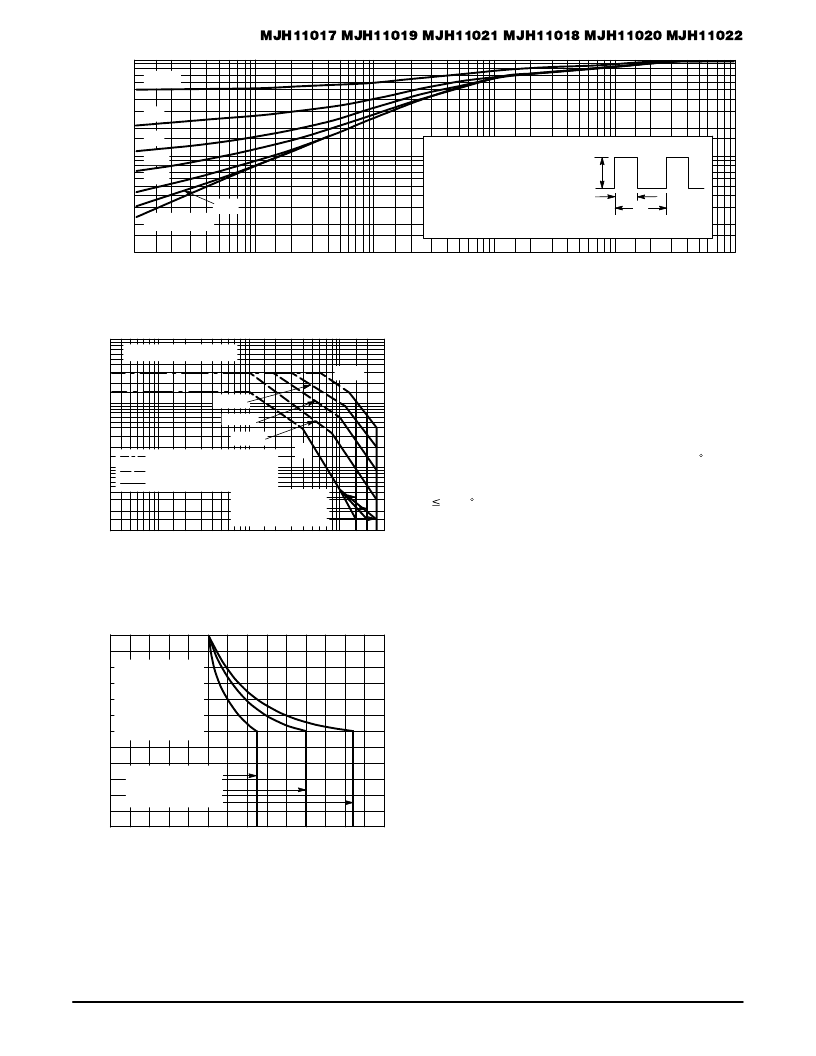- 您現(xiàn)在的位置:買賣IC網(wǎng) > PDF目錄369919 > MJH11022 (MOTOROLA INC) 15 AMPERE DARLINGTON COMPLEMENTARY SILICON POWER TRANSISTORS 150, 200, 250 VOLTS 150 WATTS PDF資料下載
參數(shù)資料
| 型號: | MJH11022 |
| 廠商: | MOTOROLA INC |
| 元件分類: | 功率晶體管 |
| 英文描述: | 15 AMPERE DARLINGTON COMPLEMENTARY SILICON POWER TRANSISTORS 150, 200, 250 VOLTS 150 WATTS |
| 中文描述: | 15 A, 250 V, NPN, Si, POWER TRANSISTOR, TO-218 |
| 文件頁數(shù): | 3/6頁 |
| 文件大小: | 212K |
| 代理商: | MJH11022 |

3
Motorola Bipolar Power Transistor Device Data
Figure 3. Thermal Response
t, TIME (ms)
1.0
0.7
0.5
0.01
0.02
0.2
0.1
0.07
0.05
0.02
r
0.05
1.0
2.0
5.0
10
20
50
100
200
500
R
θ
JC(t) = r(t) R
θ
JC
R
θ
JC = 0.83
°
C/W MAX
D CURVES APPLY FOR POWER
PULSE TRAIN SHOWN
READ TIME AT t1
TJ(pk) – TC = P(pk) R
θ
JC(t)
P(pk)
t1
t2
DUTY CYCLE, D = t1/t2
D = 0.5
SINGLE PULSE
0.1
0.5
0.2
R
1000
0.3
0.03
0.01
0.03
3.0
30
300
0.3
0.2
0.1
0.05
0.02
0.01
WIRE BOND LIMIT
THERMAL LIMIT
SECOND BREAKDOWN LIMIT
0.5 ms
Figure 4. Maximum Rated Forward Bias
Safe Operating Area (FBSOA)
1.0 ms
5.0 ms
0.1 ms
dc
VCE, COLLECTOR–EMITTER VOLTAGE (VOLTS)
2.0
30
20
2.0
I
3.0
10
10
0.5
0.2
5.0
1.0
20
100
0
TC = 25
°
C SINGLE PULSE
5.0
50
250
150
30
MJH11017, MJH11018
MJH11019, MJH11020
MJH11021, MJH11022
FORWARD BIAS
There are two limitations on the power handling ability of a
transistor: average junction temperature and second break-
down. Safe operating area curves indicate IC – VCE limits of
the transistor that must be observed for reliable operation;
i.e., the transistor must not be subjected to greater dissipa-
tion than the curves indicate.
The data of Figure 4 is based on TJ(pk) = 150 C; TC is
variable depending on conditions. Second breakdown pulse
limits are valid for duty cycles to 10% provided TJ(pk)
150 C. TJ(pk) may be calculated from the data in
Figure 3. At high case temperatures, thermal limitations will
reduce the power that can be handled to values less than the
limitations imposed by second breakdown.
VCE, COLLECTOR–EMITTER VOLTAGE (VOLTS)
20
30
140
I
60
180
100
10
20
260
220
0
Figure 5. Maximum Rated Reverse Bias
Safe Operating Area (RBSOA)
L = 200
μ
H
IC/IB1
≥
50
TC = 100
°
C
VBE(off) = 0–5.0 V
RBE = 47
DUTY CYCLE = 10%
0
MJH11017, MJH11018
MJH11019, MJH11020
MJH11021, MJH11022
REVERSE BIAS
For inductive loads, high voltage and high current must be
sustained simultaneously during turn–off, in most cases, with
the base to emitter junction reverse biased. Under these
conditions the collector voltage must be held to a safe level
at or below a specific value of collector current. This can be
accomplished by several means such as active clamping,
RC snubbing, load line shaping, etc. The safe level for these
devices is specified as Reverse Bias Safe Operating Area
and represents the voltage–current conditions during re-
verse biased turn–off. This rating is verified under clamped
conditions so that the device is never subjected to an ava-
lanche mode. Figure 5 gives RBSOA characteristics.
相關(guān)PDF資料 |
PDF描述 |
|---|---|
| MJH16006A | POWER TRANSISTORS 8 AMPERES 500 VOLTS 150 WATTS |
| MJH16006 | POWER TRANSISTORS |
| MJH16006A | POWER TRANSISTORS |
| MJH16006 | POWER TRANSISTORS 8 AMPERES 500 VOLTS 150 WATTS |
| MJH6282 | DARLINGTON 20 AMPERE COMPLEMENTARY SILICON POWER TRANSISTORS 60, 80, 100 VOLTS 160 WATTS |
相關(guān)代理商/技術(shù)參數(shù) |
參數(shù)描述 |
|---|---|
| MJH11022G | 功能描述:達(dá)林頓晶體管 15A 250V Bipolar Power NPN RoHS:否 制造商:Texas Instruments 配置:Octal 晶體管極性:NPN 集電極—發(fā)射極最大電壓 VCEO:50 V 發(fā)射極 - 基極電壓 VEBO: 集電極—基極電壓 VCBO: 最大直流電集電極電流:0.5 A 最大集電極截止電流: 功率耗散: 最大工作溫度:+ 150 C 安裝風(fēng)格:SMD/SMT 封裝 / 箱體:SOIC-18 封裝:Reel |
| MJH11022G | 制造商:ON Semiconductor 功能描述:BIPOLAR TRANSISTOR |
| MJH12004 | 制造商:Freescale Semiconductor 功能描述:SUB ONLY MOTOROLA SEMICONDUCTO |
| MJH13090 | 制造商:Rochester Electronics LLC 功能描述:- Bulk |
| MJH13091 | 制造商:Rochester Electronics LLC 功能描述:- Bulk |
發(fā)布緊急采購,3分鐘左右您將得到回復(fù)。